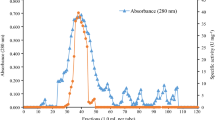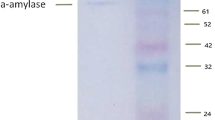Summary
Three alkaline amylases have been newly discovered in a culture medium of an alkalophilic Bacillus sp. H-167 isolated from soils. These amylases produced maltohexaose as the main product from starch. All three amylases were purified to give a single band on disc electrophoresis. They had similar properties except for molecular weight (MW) and isoelectric point (pI): optimum pH, 10.5; optimum temperature, 60°C; pH stability, 7–12; heat stability, 50–55°C; MW, 59000–80000; pI, 3.5–4.3. Metal ions such as Hg2+, Zn2+, Pb2+, Co2+ and Ni2+ inhibited the enzyme activity. All the enzymes hydrolyzed starch to produce preferentially maltohexaose, rather than maltose and maltotetraose, in an early stage of the reaction. The yield of maltohexaose reached 25%–30% from soluble starch.
Similar content being viewed by others
References
Boyer EW, Ingle MB (1972) Extracellular alkaline amylase from a Bacillus species. J Bacteriol 110:992–1000
Bradford MM (1976) A rapid and sensitive method for the quantitation of microgram quantities of protein utilizing the principle of protein-dye binding. Anal Biochem 72:248–254
Davis BJ (1964) Disc electrophoresis. II. Method and application to human serum proteins. Ann NY Acad Sci 121:404–427
Dubois M, Gilles KA, Hamilton JK, Rebers PA, Smith F (1956) Colorimetric method for determination of sugars and related substances. Anal Chem 28:350–356
Hayashi T, Akiba T, Horikoshi K (1988) Production and purification of new maltohexaose-forming amylases from alkalophilic Bacillus sp. H-167. Agric Biol Chem 52:443–448
Kainuma K, Wako H, Kobayashi S, Nogami A, Suzuki S (1975) Purification and some properties of a novel maltohexaose-producing exo-amylase from Aerobacter aerogenes. Biochim Biophys Acta 410:333–346
Kainuma K, Nakakuki T, Ogawa T (1981) High-performance liquid chromatography of maltosaccharides. J Chromatogr 212:126–131
Miller GL (1969) Use of dinitrosalicylic acid reagent for determination of reducing sugar. Anal Chem 31:426–428
Sakano Y, Kashiyama E, Kobayashi T (1983) Purification of α-maltotetraose-forming exo-amylase of Pseudomonas stutzeri. Agric Biol Chem 47:1761–1768
Takasaki Y (1982) Production of maltohexaose by α-amylase from Bacillus circulans G-6. Agric Biol Chem 46:1539–1547
Taniguchi H, Jae CM, Yoshigi N, Maruyama Y (1983) Purification of Bacillus circulans F-2 amylase and its general properties. Agric Biol Chem 47:511–519
Weber K, Osborn M (1969) The reliability of molecular weight determinations by dodecyl sulfate-polyacrylamide gel electrophoresis. J Biol Chem 244:4406–4412
Author information
Authors and Affiliations
Rights and permissions
About this article
Cite this article
Hayashi, T., Akiba, T. & Horikoshi, K. Properties of new alkaline maltohexaose-forming amylases. Appl Microbiol Biotechnol 28, 281–285 (1988). https://doi.org/10.1007/BF00250456
Received:
Accepted:
Issue Date:
DOI: https://doi.org/10.1007/BF00250456




